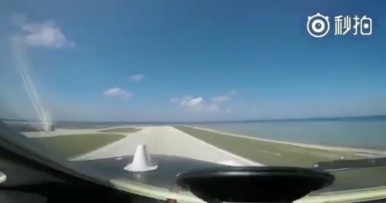"South China Sea: What China's First Strategic Bomber Landing on Woody Island Means."
Roilo: Militarization of South China Sea accelerated.
Roilo: Militarization of South China Sea accelerated.
I quote from article:
THE LONG RANGE OF THE H-6K BOMBER WOULD GIVE IT COVERAGE ACROSS NEARLY THE ENTIRE SOUTHEAST ASIA.The military significance of bomber basing at either Woody Island or the three Spratly artificial islands capable of hosting these aircraft isn’t insignificant. The long-range of the H-6K would give it coverage across nearly the entirety of Southeast Asia, excluding parts of Myanmar and Indonesia.
Roilo: Some say the existing long range missiles based in China mainland can do the same. But the bombers have more coercive presence. They are visible. They can fly over areas and conduct very coercive bomber diplomacy which missiles cannot do. Bombers can buzz like what it did over Scarborough Shoal in July 2016 on the eve of the announcement of the ruling of the Arbitral Tribunal.
THE LONG RANGE OF THE H-6K BOMBER WOULD GIVE IT COVERAGE ACROSS NEARLY THE ENTIRE SOUTHEAST ASIA.The military significance of bomber basing at either Woody Island or the three Spratly artificial islands capable of hosting these aircraft isn’t insignificant. The long-range of the H-6K would give it coverage across nearly the entirety of Southeast Asia, excluding parts of Myanmar and Indonesia.
Roilo: Some say the existing long range missiles based in China mainland can do the same. But the bombers have more coercive presence. They are visible. They can fly over areas and conduct very coercive bomber diplomacy which missiles cannot do. Bombers can buzz like what it did over Scarborough Shoal in July 2016 on the eve of the announcement of the ruling of the Arbitral Tribunal.
ALL FIVE EDCA BASES IN THE PHILIPPINES ARE COVERED. "As the Asia Maritime Transparency Initiative observed last week, “all five Philippine military bases earmarked for development under the U.S.-Philippines Enhanced Defense Cooperation Agreement” are covered by the combat radius of South China Sea-based H-6K bombers."
But the PLAAF will consider more than just combat radius in deciding when and how to base its bombers in the South China Sea. Consider that given the U.S. Navy’s forward presence in the region, any forward-based aerial assets in the Spratlys or Paracels will be vulnerable to precision strikes, making continental basing far safer. With aerial refueling, H-6 variants can extend their combat radius considerably.
MILITARIZATION TREND. "Friday’s landing crystallizes a trend that has been ongoing for months now. China is accelerating the military utility of its outposts in the South China Sea as the United States, under the Trump administration, has stepped up the tempo of its freedom of navigation operations and presence operations." @Diplomat_APAC
South China Sea: What China's First Strategic Bomber Landing on Woody Island Means
The Diplomat
Last week, on Friday, reports emerged that the Chinese People’s Liberation Army-Air Force (PLAAF) had, for the first time, landed an H-6K strategic bomber on one of the country’s South China Sea islands. China’s state-run People’s Daily shared footage of the bomber landing on an airstrip.
The island in question was Woody Island, China’s largest military outpost in the South China Sea. Woody Island sits in the Paracel Islands, but Chinese military activity there has foreshadowed possible moves in the seven artificial islands that Beijing also possesses in the Spratly group.
In addition to permanently stationing military personnel on Woody Island, China has deployed J-11 fighters, HQ-9 surface-to-air missiles, YJ-62 anti-ship cruise missiles, and other materiel there.
Recently, China has taken part of its Woody Island playbook to the Spratlys and deployed surface-to-air missiles and anti-ship cruise missilesin the Spratlys. Beijing has also deployed electronic warfare equipment to Fiery Cross Reef, one of the seven artificial islands in the Spratlys.
Friday’s H-6K landing on Woody Island likely foreshadows similar operations on Subi Reef, Fiery Cross Reef, and Mischief Reef — the three Spratly artificial islands equipped with airstrips and hangers large enough to house Xian H-6 variants, including the H-6K, all of which are heavily modified and modernized versions of the Soviet Union’s Tupolev Tu-16 twin-engine bomber.
The military significance of bomber basing at either Woody Island or the three Spratly artificial islands capable of hosting these aircraft isn’t insignificant. The long-range of the H-6K would give it coverage across nearly the entirety of Southeast Asia, excluding parts of Myanmar and Indonesia.
As the Asia Maritime Transparency Initiative observed last week, “all five Philippine military bases earmarked for development under the U.S.-Philippines Enhanced Defense Cooperation Agreement” are covered by the combat radius of South China Sea-based H-6K bombers.
But the PLAAF will consider more than just combat radius in deciding when and how to base its bombers in the South China Sea. Consider that given the U.S. Navy’s forward presence in the region, any forward-based aerial assets in the Spratlys or Paracels will be vulnerable to precision strikes, making continental basing far safer. With aerial refueling, H-6 variants can extend their combat radius considerably.
Friday’s landing crystallizes a trend that has been ongoing for months now. China is accelerating the military utility of its outposts in the South China Sea as the United States, under the Trump administration, has stepped up the tempo of its freedom of navigation operations and presence operations.

No comments:
Post a Comment